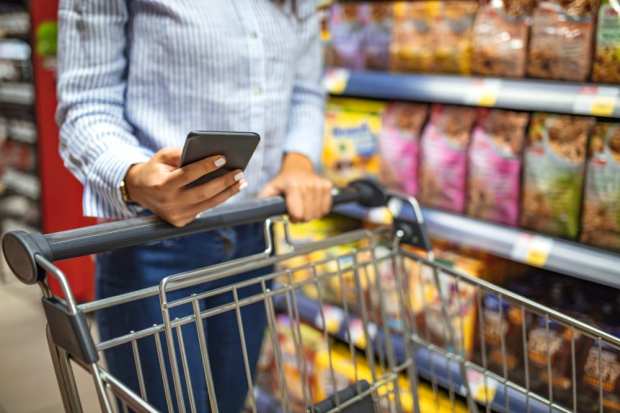The Latest Analog To Digital Battleground: Store Shelves

Sometimes, a technology takes longer than expected to find its footing in a market.
The ATM card, for example, was around for quite a while — since the early 1960s — before it fell into common use among U.S. consumers. For the first few years it was out there, consumers complained that getting money from a machine instead of a teller felt too impersonal. Time, and a big assist from the blizzard of 1978, eventually turned consumer preferences around.
It seems that electronic shelf-label technology may be taking a similar slow-burn path to growth in the U.S., particularly in the grocery market. That’s because the tech itself has been around for a while. In fact, Pricer U.S. President Charles Jackson told Karen Webster in a recent conversation, the U.S. was the first market in which the Swedish firm piloted ESL technology nearly 20 years ago — in a series of Connecticut Stop & Shop grocery stores to be specific.
“The technology was first adopted here; it just didn’t catch on the way it did globally,” Jackson said, adding that in places like Japan and Norway, ESL technology is present in 80 percent to 90 percent of retailers across a spectrum of verticals, with that number pushing 60 percent in Canada.
The problem, he said, wasn’t tech aversion or fear among Americans, but a mismatch of consumer habits and what the technology was designed to do. However, the retail marketplace in the U.S. is not the same place it was even a decade ago — customer habits are shifting, labor force pressures are realigning and digitization is permeating every aspect of the shopping experience, particularly in the competitive grocery market. Change isn’t optional, but necessary, he noted, and ESL technology can be a key cornerstone of the changes grocers need to make to their operations to stay relevant in the race.
“There are perfect storms happening around the country that are moving the dial and pushing retailers to adopt ESL, even with all the challenges, because the urgency is here,” he said.
So, how and where are retailers in the U.S. rising to meet the increasingly urgent need for change?
Curbing The Consumer’s Addiction To Shelf-Side Sales
Among retailers, Jackson noted, there is something of a running joke that the “drug addiction” powering brick-and-mortar retail in the U.S. is the shelf-side promotion. The habit is so tightly ingrained in American consumers that they walk in and start scanning those red sales tags before they are even consciously looking for the items they are there to buy. Some customers have mostly set their shopping habits to the data they see on those sale tags — if it isn’t marked as discounted, their eyes will literally not even see it.
“That habit is a hard one to break, and that has been one of the big barriers to U.S. adoption,” Jackson explained to Webster.
To break a deeply ingrained consumer habit, it is not enough to merely provide a different consumer journey, but offer a demonstrably better one that provides more end-to-end value for the consumer. How that value is delivered to the consumer can vary by context, though.
It might mean a display screen in a grocery produce section that reminds rewards customers that bananas are on special that week. In a DIY or home improvement location, it might mean interactive shelves that allow the shopper to hold up their mobile device and receive access to relevant how-to videos. It could be mean, in an electronics or apparel context, using the shelves to highlight promotions or create flash-deal experiences. It might be as simple as letting a customer know where the item they want is in the store, from the safety of their couch at home, so they can decide if it is worth their time to go out for the item.
“How to personalize mass communication is a real challenge in retail,” Jackson said, “and, at the simple use case, the technology allows them to influence price and promotions in ways that are better-suited to acquiring and retaining their customers.”
Rebuilding The Back End
The change in consumer journey is obvious and interesting, he noted, which is why it tends to draw the most attention. However, the power in ESL is often quite distant from the “bells and whistles” that attract the most attention.
Dynamic pricing, and the ability for retailers to make “a million price changes a week,” is the majority of the work done by Pricer’s system — about 80 percent price changes to some 20 percent promotion changes. Stores would make those changes if they could in a paper system, but it’s logistically impossible, which is why price changes happen once a week, with maybe another day put aside for additional adjustments.
That level of ability to customize the price is critical for the primary efficiency it generates (allowing merchants to be competitive on price in real time), as well as for the secondary efficiency it generates (freeing up staff time and improving jobs). No one in a retail organization wants to be on price-change duty, he noted, and being able to automate that job out of existence is actually somewhat critical to attracting and keeping staff in a tight labor market — where careers in brick-and-mortar retail are often measured in months, not years.
“That frees up the staff to do more important, less automatable things, like merchandising or helping customers,” Jackson said.
These upgrades should not be made lightly. For one, digitally enhanced shelving is expensive — when companies roll them out across 500 store chains, that means a significant investment in the technology alone. That investment must be made for the needs of both today and tomorrow, he explained, because this isn’t the kind of upgrade that can be redone in a year.
The challenges go beyond upgrading the technology alone. The entire store infrastructure around IT must be rethought from end to end, as this is not as simple as flipping a dynamic-pricing switch.
“There are real costs and big risks that go along with switching to ESL,” said Jackson.
However, it is a risk that retailers in the U.S. are taking as they embark on a project with Pricer in 2020. That is because customers are changing, and stores that want to change with them are increasingly seeing ESL technology as the best long-term way to do that in a brick-and-mortar context.
